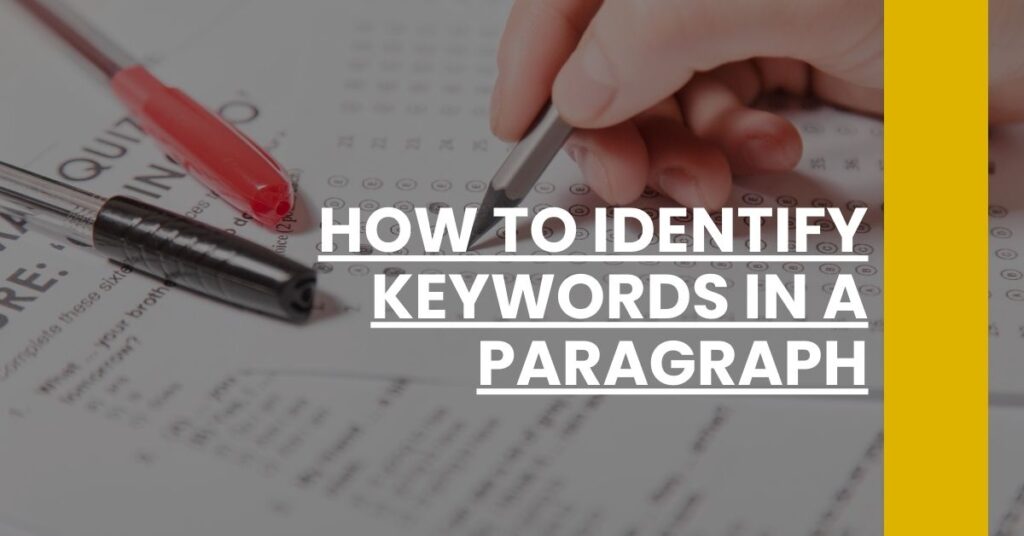Learning how to identify keywords in a paragraph is crucial for SEO and comprehension.
- SEO Outcomes: Enhance your content’s visibility with keyword optimization techniques.
- Reading Comprehension: Improve understanding of textual themes with targeted keyword identification.
- Content Strategy: Develop a robust content plan by pinpointing relevant keywords.
Mastering keyword identification sharpens SEO and reading skills.
Understanding Keywords and Their Importance
Keywords are the linchpin in the machinery of both understanding written content and optimizing for search engines. When you read a paragraph, keywords help you to quickly grasp the main themes and ideas the author is communicating. For content creators, keywords serve as a beacon for search engines, guiding them to your content amidst the vast ocean of the internet. Being adept at identifying keywords in a paragraph is crucial for enhancing reading comprehension, improving study techniques, and refining search engine optimization (SEO) strategies.
Why Are Keywords Essential for Readers?
For readers, keywords unlock the message within the text. They are like signposts that lead you through the landscape of ideas, highlighting important junctions or destinations. By recognizing these keywords, you bolster your understanding, retain information more effectively, and even categorize knowledge for future reference.
The Impact of Keywords on SEO
In the realm of SEO, keywords are instrumental in connecting your content with your audience. They act as the matchmaker between a user’s search query and your website’s content. Skillfully chosen keywords can propel your page to the top of search results, thereby increasing visibility and organic traffic.
Here’s a rundown of the methods that will empower you to answer that critical question: How to identify keywords in a paragraph?
Initial Read-Through Tips
Engaging with a paragraph for the first time? Take these steps to ease into the treasure hunt for keywords:
- Read for Context: Grasp the general theme. What is the paragraph about?
- Note Any Standouts: Are there words that seem central to the point being made? They’re likely your keywords.
- Emotional Response: Pay attention to words that trigger an emotional response—they often bear significance.
- Structure: The first and last sentences often carry the kernel of the main idea; scout for keywords there.
How Does Skimming Aid in Keyword Identification?
Skimming is a surface-level reading strategy where you glide over the text to pick out prominent words or phrases. While skimming, your brain naturally hones in on words that are bold, in italics, or otherwise set apart.
The Role of Context in Identifying Keywords
Think of context as the supportive friend of keywords; it gives them meaning and helps them shine. Here’s why context is indispensable in identifying keywords in a paragraph:
- Words in Company: Keywords often travel in packs. Look at the words surrounding a potential keyword; they will tell you if you’re on the right track.
- Purpose of Paragraph: Understanding why the author wrote the paragraph provides clues to what is important.
Synonyms and Their Significance
Keywords have doppelgängers, also known as synonyms, which can echo the same idea in different attire. Track these linguistic twins and you’ll have a broader spectrum of keywords at your disposal.
Can Subheadings and Titles Be Clues?
Absolutely! Subheadings and titles are like spoilers; they often encapsulate the primary concepts. If you’re short on time, these are great areas to scan for quick keyword extraction.
Keyword Identification Techniques
Knowing how to identify keywords in a paragraph is an art as much as it is a technique. Here, the brushstrokes revolve around specific tactics that can help you extract the most out of a text.
- Density Matters: Is a particular term popping up frequently? High frequency can be a tell-tale sign of a keyword.
- Uniqueness: Uncommon or specific terms that stand out amidst more generic language are often keywords.
- Thematic Words: If a word encapsulates the theme or subject matter of the paragraph, it’s likely a keyword.
- Structural Cues: Often, authors will signal importance by embellishing words – think bold, italics, or underlining.
- Specialist Language: Jargon or technical terms that relate to the field at hand are almost always keywords.
Overcoming the Ambiguity of Language
It’s the norm for words to carry multiple meanings; identifying keywords requires you to interpret them in the context of the paragraph. The subtleties of tone, nuances of language, and the author’s intent, all play a pivotal role in determining the true ‘stars’ of the paragraph.
Incorporating SEO Tools for Precision
Sometimes the human eye needs a digital ally. SEO tools like SEMrush’s Keyword Magic Tool help distill a paragraph to its essence, presenting you with a list of potential keywords that you might have overlooked. It’s a seamless way to validate your findings or discover new avenues.
Familiarizing oneself with these skills isn’t just about enhancing literacy or getting a leg up in the digital marketing world—it’s about joining conversations with clarity and contributing to them meaningfully. Unpack a paragraph with these strategies, and you’ll be a maestro of keywords in no time.
Using Tools to Highlight Keywords
In the digital space, SEO tools and software are the trusty sidekicks that save the day when you’re grappling with how to identify keywords in a paragraph. A blend of technology and strategic insight streamlines the keyword identification process, helping you to peel back the layers of text and reveal the core keywords around which a piece of content orbits.
Embracing Technology for Enhanced Keyword Spotting
Imagine if you had a highlighter that could magically discern and emphasize the keywords in a paragraph. That’s what certain online tools are designed to do. They leverage algorithms to assess patterns, word frequency, and relevance, turning a time-consuming task into a matter of seconds. Tools like Ahrefs and Moz Keyword Explorer offer functionalities that cater beyond simple search volume data, providing insights into keyword density and context.
- Keyword Density Analyzers: These can spot keywords that are used most frequently within the text.
- SEO Platforms: Tools like SEMrush and Moz incorporate multiple keyword-related features, like SERP analysis, which can shed light on how competitive a certain keyword is.
While such tools offer excellent guidance, remember that algorithms aren’t perfect reflections of human nuance. The human touch is still essential for interpreting the subtleties of language that software may miss.
Practice and Application
You’ve got the theoretical knowledge—but like any skill, identifying keywords gets better with practice. Applying these techniques across varied paragraphs will not only sharpen your ability, but also tune your instinct for swiftly pinpointing keywords.
Exercises for Honing Your Keyword Detection Skills
Grab a selection of articles, blogs, or even books, and give yourself the task of extracting keywords. Here is how you can approach the exercise:
- Select a Diverse Range of Texts: Exposure to different writing styles is beneficial.
- Time Yourself: Challenge your speed and accuracy in identifying keywords.
- Reflect and Analyze: Compare your chosen keywords with others who have read the same text.
- Use a Tool: Try out one of the SEO tools to see if your manual selections align with the software’s findings.
By engaging in active practice, you’ll develop an innate sense of what deserves the keyword spotlight in any paragraph.
Challenges in Keyword Identification
Even seasoned SEO experts face challenges when identifying keywords in a paragraph. The good news is, every challenge is a learning opportunity that sharpens your skills over time.
The Multiple Meanings Dilemma
Words are chameleons, shifting meanings according to context. This variability can lead to ambiguity when picking out keywords. To navigate this:
- Expand Your Vocabulary: The more words you know, the better you’ll be at deducing meaning from context.
- Understand Nuance: Investigate not just the word, but how it’s used. Habitat in biology carries a different weight than habitat in real estate content.
Synonyms and Variations
A keyword can wear different hats—synonyms, long-tail variations, and industry-specific jargon can all represent the same concept. Research and insight are your allies here, helping you to recognize when two different phrases serve the same purpose.
- Employ a Thesaurus: Not just for finding synonyms, but understanding the breadth of a keyword’s reach.
- Continual Learning: Keep abreast of industry-specific language evolutions and how they impact keywords.
Conclusion: Reinforcing the Keyword Identification Habit
Becoming proficient at identifying keywords is akin to building muscle memory. Engage in regular practice, complement your efforts with technology, and stay curious about the ever-evolving nuance of language. Acknowledging the pivotal role that keywords play in both comprehension and SEO will ground your content strategy in relevancy—connecting with your audience on a more profound level.
In mastering how to identify keywords in a paragraph, you gift yourself with a versatile skill that translates across numerous personal and professional realms. It’s a blend of science, art, and a touch of digital savvy that makes for better reading, writing, and content discovery. Embark on this journey with an open mind—the paragraphs of the world await your discerning eye.
Learn how to identify keywords in a paragraph to enhance reading comprehension and SEO with practical strategies and tips.

